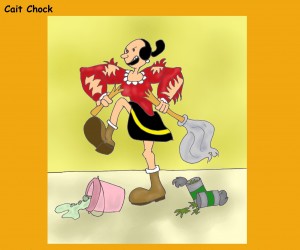Running with low iron levels feels like you’ve got 200-pound dumbbells strapped to you and you’re running at a tempo effort…then you look down at your watch and want to cry because the pace is slower than you used to do your easy runs. Sounds like fun, huh?

Actually, some people aren’t able to workout if they have been anemic for quite a while. Low iron levels is not a rare problem with distance runners, or endurance athletes in general, and while women are especially prone to it, I think it’s important to understand that endurance athletes, regardless of gender, have to be careful to watch their iron levels:
* Stronger hearts and higher blood volume. This is all great when it comes to performance but with a higher amount of blood in the body it can dilute the amount of iron present.
* Healthy diets. Again a positive, but if an athlete is eliminating a lot of iron rich foods because they are deemed ‘unhealthy’ in other ways, this can lead to diminished iron stores. (ie: red meats, egg yolks)
* Running. I didn’t realize this but in each foot fall to the ground we are engaging in what is known as ‘foot strike hemolysis’. What this means is each time your foot plants it is breaking up red blood cells that carry iron. This is more so in larger runners, but we all do it.
* Blood loss.Obviously women lose iron and blood through *ahem, we know what* but trace amounts are lost in both sweat and urine too. Now, if you’re having blood lost in your GI tract, that compounds the problem but is also indicative of bigger issues you need to get addressed.
The thing is that having low iron levels doesn’t only effect how you feel…low energy is usually a red flag but if you go too long with low iron you’re setting yourself up for potential injuries like stress fractures. Being anemic for too long can lower your bone density and lead to osteoporosis.
How do you know if you have low iron levels, and what’s a ‘normal’ level? Unfortunately, it usually isn’t until you feel the effects of anemia that you think about getting tested. This is when you’re times start to drop and you constantly feel like you’re dragging. This is another reason why getting a blood panel done whenever you aren’t ‘feeling right’ in your runs is smart.
Runners put a lot of stress on our bodies but we are also more in tune with them than the average folks. We can tell if something is going awry; also, when we want our bodies to perform at 100%, we notice when we’re off sooner than just sofa surfers. To athletes, even a 10% drop in how we feel is a lot.
In asking Cal Poly coach Kelly Strong how she handles athletes that experience a sudden drop in performance, she answers, “For someone going through these types of situations, the first thing I would ask is about their sleep, nutrition, iron levels, etc.” For good reason, and in fact, it’s not a bad idea to keep tabs on your iron (and other important stats) every now and again to make sure everything is on the up and up.
Getting back to what are ‘normal’ levels, again it’s different for athletes. Here’s an excerpt from Pete Pfitzinger’s site:
You should find out both your hemoglobin and serum ferritin levels. Normal hemoglobin concentration ranges from 14 to 18 grams per 100 ml of blood for men, and 12 to 16 grams per 100 ml of blood for women, but for an endurance athlete, the lower end of normal should be extended by about 1 gram per 100 ml, due to our larger blood volume.
Ferritin is a measure of your body’s iron stores. Normal reference ferritin levels are 10-200 ng/ml for women and 10-300 ng/ml for men.
Dr. Martin says that in his experience with runners, training and racing performances are usually affected when ferritin levels drop below 20 ng/ml, and that when those athletes increase their ferritin levels above 25 ng/ml they experience a rapid turnaround in performance.
Personal anecdote here, I’ve had experience with low iron, and I remember being tested and having been in the low teens…it was not pretty. I actually went through a series of iron infusions (think three days of sitting with an IV drip lasting 3 hours…your mouth tastes like pennies!) to quickly boost the iron levels. From there I now always take a supplement in addition to what I eat naturally. I know of other runners who have gone the liquid iron route, I’ve never had those but they seem to get the job done too.
Again, I’m not a doctor, but when I was training at a high level it was the norm for everyone to get bloodwork on a consistent basis. We shot for our ferritin levels to be around 100. Again, yes, that is higher than what is ‘normally’ recommended, but better safe than sorry, right?
Some quick notes:
* If you aren’t feeling well in your runs and things continue to go downhill regardless of backing off and more easy days…go in and get a blood panel done. Make sure they test you iron levels and REALLY hound your doctor if you have to. Doctors are very busy but demand their attention and explain that you are an athlete. Get your coach involved (they should be already by this point if you have one) and they can help.
* DO NOT pound a ton of iron pills all at once. This will make you feel REALLY sick and it could be dangerous. I take a supplement with 65 mg of elemental iron; start with just one a day and gradually build your way up if you need to. If you’ve got a background of anemia, I’d suggest taking a supplement in addition to aiming to get iron in the foods you eat.
* IV’s and liquid iron are in more severe cases but not something to be afraid of. Talk to your doctor and a quick boost can work wonders…you’d be surprised how quickly you can feel the turn around once your levels are getting back up there.
Some high iron foods include: spinach, legumes, liver (yum!), oysters, lean meats, dried fruits, egg yolks, as well as whole grains and cereals that are iron enriched.
Things that block the absorption of iron are having tea and coffee with these foods. Conversely, having something with vitamin C in it will HELP iron absorption. Another quote from Pfitzinger, “You will absorb three times as much iron from your cereal and toast if you switch from coffee to orange juice with breakfast.”
So if you’re not sold on pumping the iron into your blood yet, then you may just have to figure it out for yourself the hard way. Best of luck tackling those PR’s with the 200-pound weights strapped to your back. 😉
—————-
Stephanie Rosthstein has been making some headlines lately in talking about her struggles with not just low iron but getting diagnosed with celiac disease (which was blocking her iron absorption). HERE and HERE are two articles about how she’s gotten her issues resolved. In case you have a brain fart, she was just in the US Olympic Marathon Trials. 🙂
—————-
1) Have you ever had low iron levels?
2) Do you make an effort to get more iron into your diet? Do you take a supplement?
3) How do you tell if something is going awry in your body? Has being an athlete given you an early heads-up and sent you in to figure out if there was something wrong?
After my fun adventures with anemia I later got to ride the wild roller coaster of hypothyroidism…fun tales for next time. 😉



I never had low iron, but have been tested many times when I had the symptoms. I do take a iron supplement (with Vitamin C) once in a while.
hey, better safe than sorry, really i tell everyone to take one regardless! 🙂
My iron levels are sub-arctic!
Even before I became vegetarian I had trouble holding onto iron stores but now I have to be extra careful 🙂 I can’t take iron tablets (not happy tummy if I do) so I get injections every couple of months. Not ideal, but hey if it keeps me on my feet and running 🙂
I think when you start paying more attention to your body and loving it and respecting it with exercise you do start picking up on signals earlier and checking out what isn’t “normal”.
i know, i read about that, u poor thing!! sorry to hear the pills are tough on ur tummy (were u eating them on an empty stomach, sometimes that can do it) but at least u have found the injections work. ya, shots suck, but being anemic is suckier! 😛
I’ve never had low iron levels! I’ve been tested just to see, not because I ever felt the way anemia makes you feel, and it was fine. It’s weird because I’m a vegetarian and don’t eat a ton of iron rich foods. I guess I’m just lucky! I didn’t know about the foot strike hemolysis, but that’s really interesting! I never would have thought of that!
ya, i say better safe than sorry and get the levels checked regardless…happy to hear that u’re levels are fine, u must be doing a super job eating the iron! 🙂
Low iron, mid-distance female runner here. Increasing iron-rich foods and taking a daily supplement made a huge difference in my iron levels. It took about 8 months to get my iron store levels back up. Interesting about Celiac. That info is new to me.
thanks for the visit and oh my gosh, i luv ur blog drawings!! power to the arty people who don’t like to post actual pictures of themselves! 😉 always LUV a fellow runner visit too, but i’m sorry u also had to deal with low iron…i’m glad that u’re all back and better now though.
I;ve never had low iron levels but I would trust Tri-girl with whatever she says 🙂 lol
hehe….ya, she seems like a cool chick 😉
I had low iron the last time I was tested and made a real effort to eat more sources of iron – along with citrus fruits at the same time. I definitely felt better!
i’m glad u were able to get ur levels back up and are back there powering at full strength…i’m so happy u’re back at the running sans injury!! hurrah! 😉
Such a wonderful and important reminder — as a vegan athlete, I have to be extra careful to eat foods that are packed with iron – sometimes doing that can be a real challenge.
thanks! ya, i know that because i’m not a big red meat eater i have to look for iron in other ways. 🙂
Very good info to post! I have totally been there! I must say it’s nice not feeling like the girl in your first illustration all of the time:)
haha…ya, it’s crazy how nice it feels to finish a workout and not feel like u’re dying AND the times are ridiculous! 😛
ooo yeah, I had a lovely bout of anemia a year ago actually! it was awful. Like, forget running…I didn’t even want to work out. I would sleep for like 14 hours straight and still feel like poop! I take supplements now and its all straightened out, and now I definitely get a full blood workup 2x a year just to stay on top of things. I learned the hard way, but I can definitely say supps and tests are worth it!
glad u’re feeling better and i totally agree, i’m a supp girl for life! 🙂
Pingback: Running in the ‘Wrong’ Kind of Tired: Diagnosis and solving a constant state of fatigue |
Pingback: Kale Video: Like cabbage only cooler |